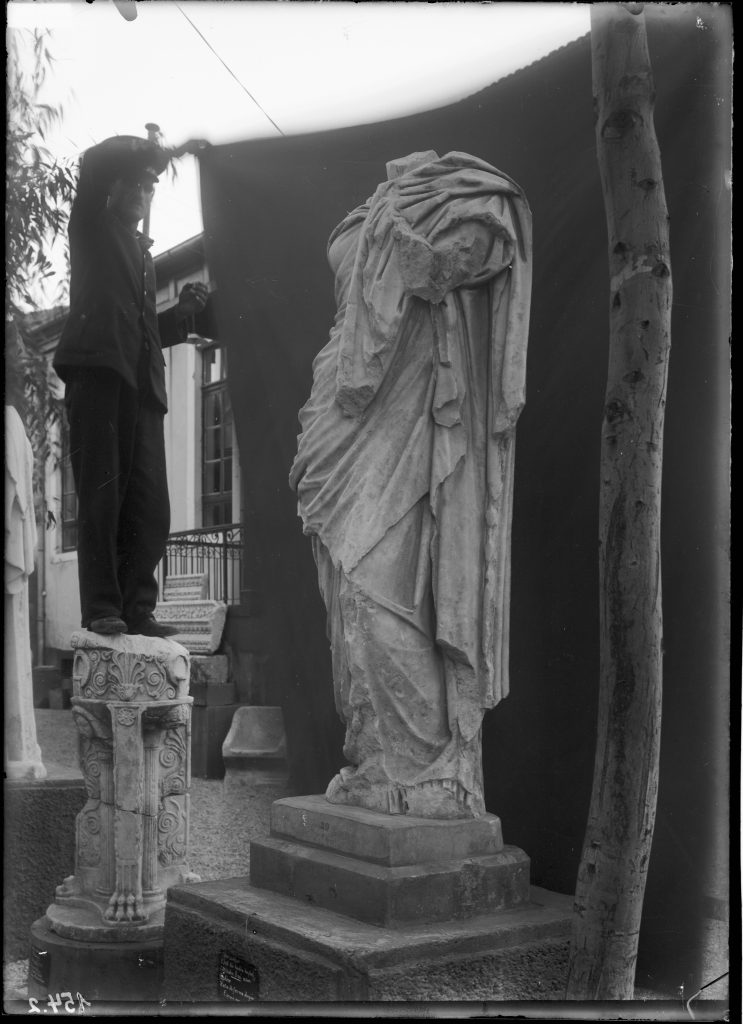The monthly photo that we selected from our archive shows preparations being made for some field photography. The photographer, who may have accidentally released the shutter button, recorded this wonderful moment. Documentation of archaeological sites by photography gradually replaced the picturesque engravings of the ruins drawn by 19th-century travellers who sometimes added imaginary elements. Photography – with all its objectivity – replaced these orientalist drawings. Over the years archaeological photography became a sub-discipline of photography. It is used to document all the stages of work at an archaeological site, including all the different steps of an excavation, subsequent laboratory processes as well as for museum inventories. Contrary to the photographs that we encounter everywhere today, which often manipulate reality as much as possible, archaeological photography has to reflect the reality as it exists at that moment. It leaves the viewer alone with archaeology and does not insert any subjective interpretation. Appropriate light and cleanliness of the area are important factors. In other words, taking an archaeological photo can involve long preparation. As in this photo, very likely taken in a the garden of a museum, this preparation is sometimes a little tricky. The person holding the curtain, who could be the guard of the museum, is seen in his attempts to keep out of shot in the other photographs of this series stored in our archive.
Arşivimizden seçtiǧimiz ayın fotoǧrafında bir arkeoloji fotoǧrafının hazırlık evresi görülmekte. Büyük olasılıkla yanlışlıkla deklanşöre basan fotoǧrafçı bu sevimli anı kayıt altına almış. Arkeolojik alanların fotoǧraf yolu ile belgelenmesi, 19. yüzyıl seyyahlarının kimi zaman hayali unsurlar da katarak çizdikleri pitoresk ören yeri gravürlerinden hemen sonraya denk gelir. Fotoǧraf, tüm nesnelliǧi ile bu oryantalist çizimlerin yerini almıştır. Yıllar içerisinde arkeoloji fotoǧrafçılıǧı denilen bir alt disiplin ortaya çıkmıştır. Kendine has teknikleri olan arkeoloji fotoǧrafçılıǧında, eserin kazı öncesi, kazı sonrası, laboratuar süreci ve müze envanterlerine kadar geçirdiǧi tüm evreler belgelenir. Günümüzde her yerde karşımıza çıkan, gerçeǧi olabildiǧince manipüle eden fotoǧrafların aksine arkeoloji fotoǧrafı gerçeǧi gözün gördüǧü şekilde yansıtmaya çalışır. Fotoǧrafa bakanı arkeoloji ile yalnız bırakır; araya hiçbir öznel yorum sokmaz. Uygun ışık, çekilecek alanın veya objenin temizliǧi ve uygun kompozisyon çok önemlidir. Yani fotoǧrafın uzun bir hazırlık evresi vardır. Müze bahçesinde çekilen bu fotoǧrafta olduǧu gibi kimi zaman hazırlık aşamaları biraz zorlu da olabilir. Muhtemelen müzenin bekçisi olan perdeyi tutan bu kişi, arşivdeki bu çekim gününe ait diǧer fotoǧraflarda hep saklanmaya çalışırken görülmekte.
D-DAI-IST-4137, Photographer and date unknown/ Fotografçı ve çekim tarihi bilinmiyor

